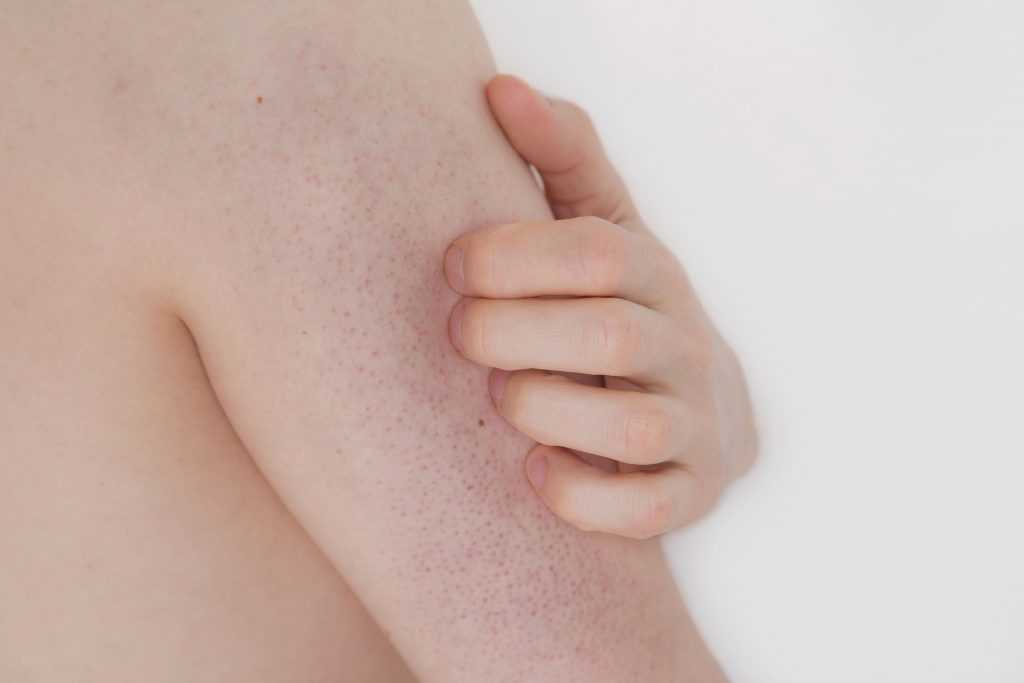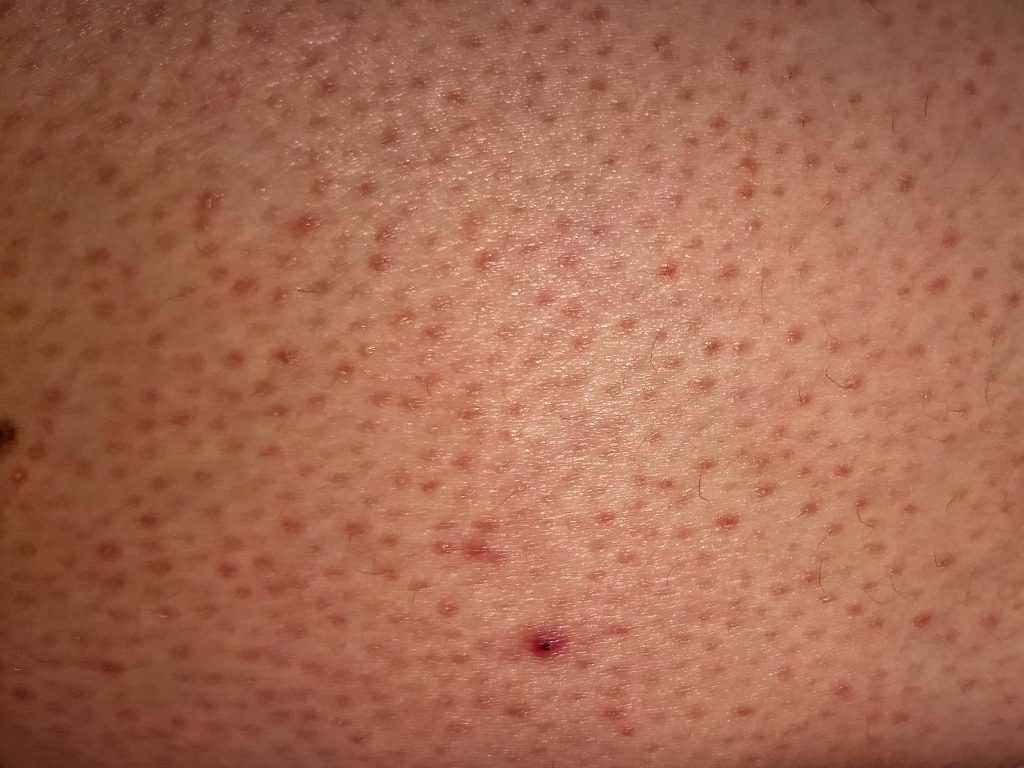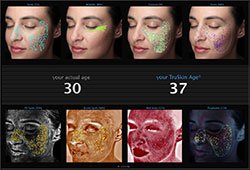What is Keratosis Pilaris?

Keratosis Pilaris is a common, benign, skin condition that can affect children and adults. One of the most common skin conditions in the world keratosis pilaris affects one in every three people in their lifetime.¹ Keratosis Pilaris is often described as goose/chicken bumps or chicken skin. This is because it is characterized by patches of red, rough skin with small bumps are most often seen in the backs of the upper arms, the thighs, cheek, or the buttocks. It is caused by the build-up of the skin protein, keratin, within the follicles, the openings in your skin from which your hairs grow.² The “plugs” of keratin and dead skin can cause damage to the follicle. The red bumps across the skin are irritated follicles. Doctors have also found that tightly coiled hair shafts in the follicle can cause similar damage. It is often associated with other skin disorders like dry skin and acne.
Symptoms of Keratosis Pilaris

Keratosis pilaris is considered harmless, though their appearance may be visually upsetting. Its presence can affect the confidence of those afflicted and may even cause mental scarring in some cases. Some of the more common symptoms of keratosis pilaris are following:
Bumpy Skin: The affected area of skin is covered in tiny painless bumps. The more common areas for this symptom to appear is on the cheeks, upper arms, thighs, and buttocks.
Rough Skin: Sometimes the presence of keratosis pilaris may be accompanied with rough skin texture around the affected areas.
Itching: In some cases, there may be instances of mild itching in the affected area of skin.
What Factors Can Make My Keratosis Pilaris Worse?
Although it has already been established that keratosis pilaris is caused by a build up of keratin in the hair follicles. Exactly what causes the build up of keratin to happen is unknown. However, there are a few factors that might increase the likelihood for someone to have a keratosis pilaris outbreak.³
Obesity
Genetics
Dry Skin
Colder Climates
Ichthyosis Vulgaris
Hay Fever
Certain Medications: Patients being treated for melanoma may be prescribed vemurafenib. One of the possible side effects of vemurafenib is the development of keratosis pilaris. The severity of symptoms may increase with dosage but subsides once patient finishes taking it.
Treatments Available for Your Keratosis Pilaris
 VISIA Skin Analysis: For any of our clientele who has concerns about their skin health, Epiphany Dermatology recommends they undergo a scan by the VISIA Skin Analysis System. We use the VISIA Skin Analysis System to learn as much as possible about each client’s unique skin care needs. After their exam and analysis, a customized treatment plan will be provided to them, with clear and careful instructions.
VISIA Skin Analysis: For any of our clientele who has concerns about their skin health, Epiphany Dermatology recommends they undergo a scan by the VISIA Skin Analysis System. We use the VISIA Skin Analysis System to learn as much as possible about each client’s unique skin care needs. After their exam and analysis, a customized treatment plan will be provided to them, with clear and careful instructions.
 Skin Care Products: For our clients who are suffering from keratosis pilaris, Epiphany Dermatology can recommend a variety of moisturizers that contains urea or lactic acid to help remove build-up from follicles. Check out Epiphany Dermatology’s Online Store for more information.
Skin Care Products: For our clients who are suffering from keratosis pilaris, Epiphany Dermatology can recommend a variety of moisturizers that contains urea or lactic acid to help remove build-up from follicles. Check out Epiphany Dermatology’s Online Store for more information.
* It is important to be mindful of sun exposure to avoid conditions like hyperpigmentation and skin cancer. Epiphany Dermatology recommends a wearable sun monitoring device from Eclipse Rx.
 Microdermabrasion: Microdermabrasion is a non-invasive treatment that gently remove the outer layer of skin. This is a very effective treatment that leaves the skin smoother and more evenly toned.
Microdermabrasion: Microdermabrasion is a non-invasive treatment that gently remove the outer layer of skin. This is a very effective treatment that leaves the skin smoother and more evenly toned.
Chemical Peels: Chemical Peels are effective treatment for many skin concerns, including keratosis pilaris. Chemical Peel cause the epidermis layer of skin to peel away promoting the skin beneath to grow in smoother and healthier looking. Epiphany Dermatology provides several choices of chemical peel packages to suit each patient’s individual needs.
¹Ally N Alai, M. F. (2018, June 12). Keratosis Pilaris. Retrieved from https://Medscape.com:
https://emedicine.medscape.com/article/1070651-overview
²Mayo Clinic Staff. (2018, March 7). Keratosis pilaris. Retrieved from https://www.mayoclinic.org:
https://www.mayoclinic.org/diseases-conditions/keratosis-pilaris/symptoms-causes/syc-20351149
³Cynthia Cobb, A. (2017, October 25). Keratosis Pilaris (Chicken Skin). Retrieved from https://www.healthline.com:
https://www.healthline.com/health/keratosis-pilaris
For more information about how to treat your Keratosis Pilaris, please contact Epiphany Dermatology
Our Riverside Location:
805 NW Platte Rd., Suite 120
Riverside, MO 64150 | CLICK HERE for Directions
Phone: (816) 205-8120
SEND US AN E-MAIL
Our St. Joseph Location:
805 N 36th St., Suite D
St. Joseph, MO 64506 | CLICK HERE for Directions
Phone: (816) 205-8120
SEND US AN E-MAIL

